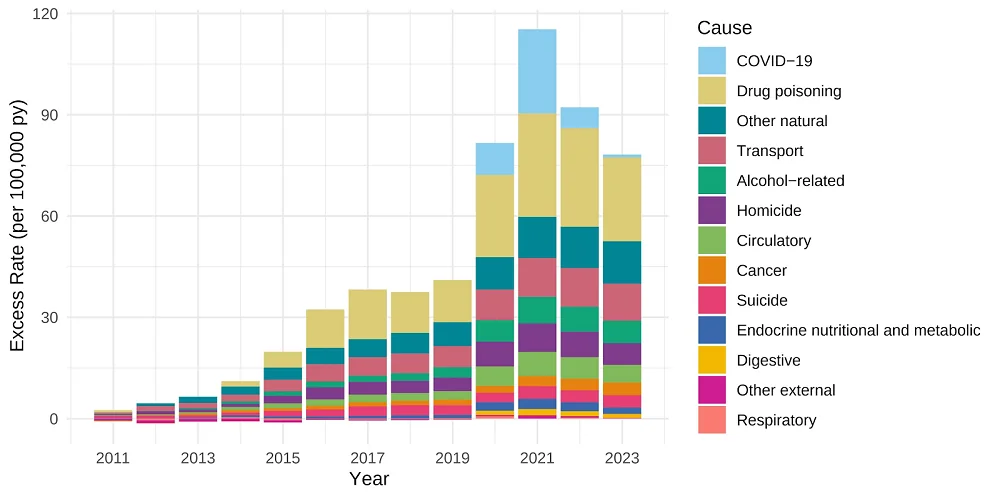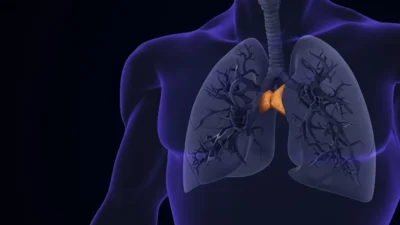Mortality among Americans aged 25-44 has risen substantially between 2011 and 2023, a new study has found, and it remains high even after having passed the COVID-related peak [1].
Riches to rags
Despite the US being one of the world’s richest countries, Americans’ average life expectancy has been lagging behind that of comparable countries by more than four years (even more when compared to top performers such as Spain and Japan). The gap has widened substantially starting at around 2010, when US life expectancy growth ground to a halt and later took an unusually hard hit during the COVID-19 pandemic (interestingly, it was followed by a robust rebound in 2022 and 2023).
Part of this multifaceted phenomenon is increased mortality in young adults. While much of it has been driven by an epidemic of illegal drugs, deaths of natural causes such as cancer have also skyrocketed. This trend worries researchers and policymakers and is being actively investigated.
Not just COVID
In a new study that originated from the University of Minnesota and Boston University and was published in JAMA Open Network, the researchers took an unusually long perspective to analyze the dynamics of excess deaths in American adults aged 25-44. The team used 2010 as their baseline and defined excess mortality as that exceeding extrapolation of 1999-2010 trends.
Having analyzed 3,392,364 deaths, they found that excess mortality per capita in this category began to rise well before the pandemic. In 2019, it was 34.6% higher than expected (i.e., had pre-2011 trends continued).

The pandemic brought another sharp increase in mortality, two major drivers being COVID-19 and drug overdoses. However, deaths from multiple other causes, including cancer, circulatory problems, and metabolic diseases, increased as well. Some of these may be connected to COVID, as studies have linked COVID infection to various complications such as cardiovascular conditions [2], or substance abuse. As a result, in 2021, all-cause excess mortality was almost three times what it had been in 2019 (116.2 vs 41.7 deaths per 100,000 population).
A complex phenomenon
Hinting at this interconnectedness is the fact that after 2021, excess mortality began to fall in several categories, such as cardiometabolic conditions. However, even for these causes, excess mortality remains much higher than pre-pandemic levels. All-cause early adult mortality was 70.0% higher in 2023 than it would have been had pre-2011 trends continued. In absolute numbers, this excess mortality translates into 71,124 deaths annually.
This might be partially due to the long-lasting effects of COVID, which are only beginning to attract researchers’ attention (“long COVID” and other complications). Another possible explanation is that drug- and alcohol-related deaths are still very high compared to a decade ago. Substance abuse is associated with multiple health hazards and might drive other causes of death.
The top five causes of death that collectively accounted for nearly three-quarters of the excess mortality in 2023 were drug poisoning (31.8% of excess mortality), the residual natural-cause category (16.0%), transport-related deaths (14.1%), alcohol-related deaths (8.5%), and homicide (8.2%). “Additionally, the combined contribution of cardiometabolic conditions, including circulatory and endocrine, metabolic, and nutritional, was substantial (9.2%),” the paper notes.
“The rise in opiate deaths has been devastating for Americans in early and middle adulthood,” said Elizabeth Wrigley-Field, lead author and an associate professor in the University of Minnesota College of Liberal Arts and Institute for Social Research and Data Innovation. “What we didn’t expect is how many different causes of death have really grown for these early adults. It’s drug and alcohol deaths, but it’s also car collisions, it’s circulatory and metabolic diseases – causes that are very different from each other. That tells us this isn’t one simple problem to fix, but something broader.”
“Our findings underscore the urgent need for comprehensive policies to address the structural factors driving worsening health among recent generations of young adults,” said author Andrew Stokes of Boston University. “Solutions may include expanding access to nutritious foods, strengthening social services and increasing regulation of industries that affect public health.”
Cancer is on the rise
While most natural causes are declining, cancer is an outlier, with excess mortality at an all-time high. A large-scale study in The Lancet last year found that cancer prevalence has increased in young compared to older cohorts, particularly in Generation Xers and millennials, for 17 out of 34 cancer types [3]. Alarmingly, cancer is often more aggressive in younger people.
This hike in cancer incidence has happened despite a declining prevalence of smoking and some other unhealthy behaviors. On the other hand, factors such as alcohol consumption, obesity, ultra-processed food consumption, and environmental pollution remain a challenge. A recent advisory from the US Surgeon General warns that alcohol is a major risk factor for cancer.
However, early detection might also have contributed to the rates of cancer in earlier cohorts. Some slow-growing cancers might be detectable now at earlier ages, affecting the statistic.
The lost Americans
Interestingly, the US was not always behind its peers in life expectancy. In 2023, a study by the University of Boston scientists aptly named “Missing Americans: Early death in the United States” stated that “The United States had lower mortality rates than peer countries in the 1930s-1950s and similar mortality in the 1960s and 1970s. Beginning in the 1980s, however, the United States began experiencing a steady increase in the number of missing Americans, reaching 622,534 in 2019 alone.” [4] The situation got much worse during the COVID-19 pandemic.
The authors of that study attributed the growing discrepancy to the lack of large-scale public health initiatives in the US. “While COVID-19 brought new attention to public health, the backlash unleashed during the pandemic has undermined trust in government and support for expansive policies to improve population health,” said the study’s lead and corresponding author Jacob Bor, associate professor of global health and epidemiology, at the time. “This could be the most harmful long-term impact of the pandemic, because expansion of public policy to support health is exactly how our peer countries have attained higher life expectancy and better health outcomes.”
Literature
[1] Wrigley-Field, E., Raquib, R. V., Berry, K. M., Morris, K. J., & Stokes, A. C. (2025). Mortality Trends Among Early Adults in the United States, 1999-2023. JAMA Network Open, 8(1), e2457538-e2457538.
[2] Lee, C. C., Ali, K., Connell, D., Mordi, I. R., George, J., Lang, E. M., & Lang, C. C. (2021). COVID-19-associated cardiovascular complications. Diseases, 9(3), 47.
[3] Sung, H., Jiang, C., Bandi, P., Minihan, A., Fidler-Benaoudia, M., Islami, F., … & Jemal, A. (2024). Differences in cancer rates among adults born between 1920 and 1990 in the USA: an analysis of population-based cancer registry data. The Lancet Public Health, 9(8), e583-e593.Chicago
[4] Bor, J., Stokes, A. C., Raifman, J., Venkataramani, A., Bassett, M. T., Himmelstein, D., & Woolhandler, S. (2023). Missing Americans: early death in the United States—1933–2021. PNAS nexus, 2(6), pgad173.







